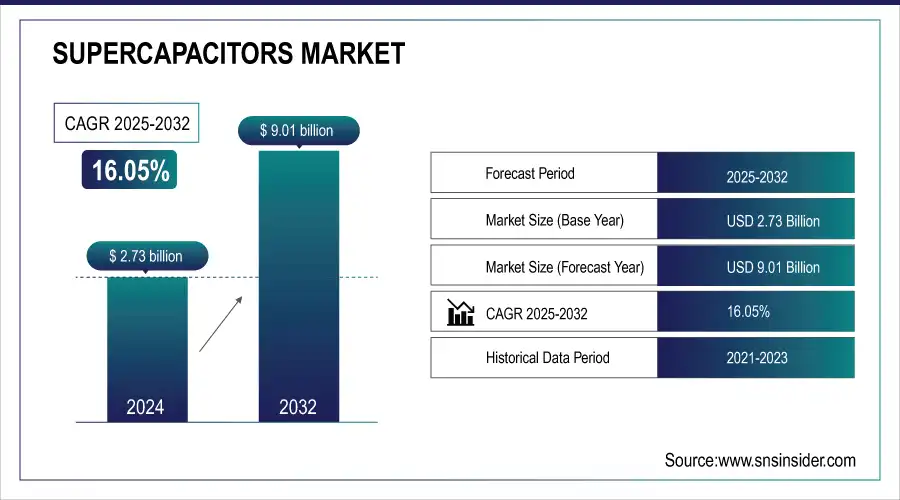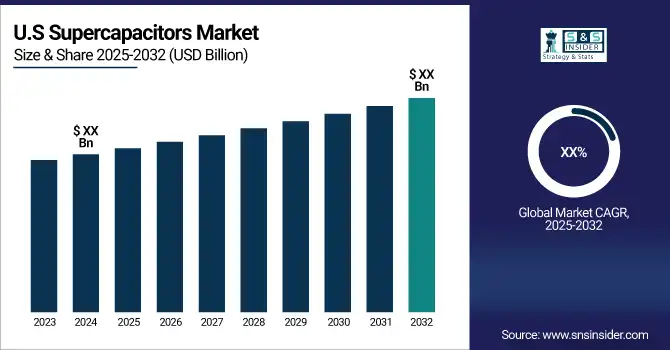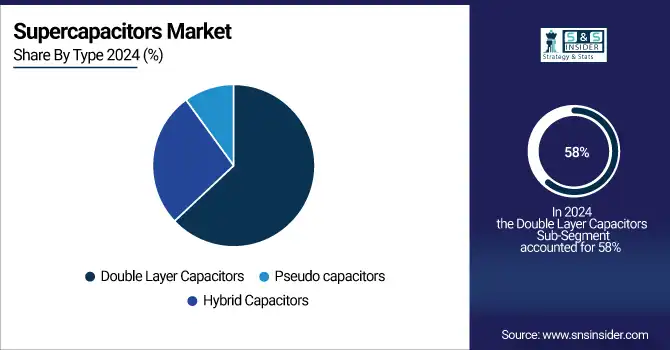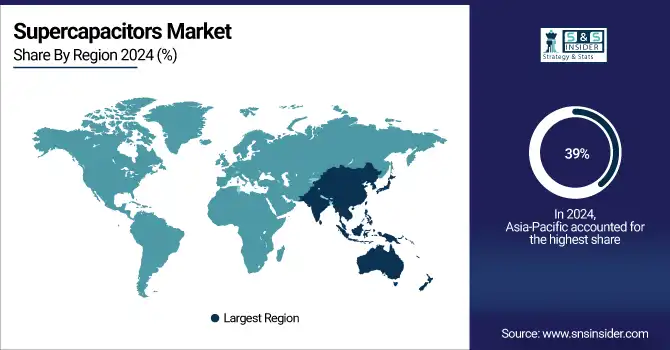Supercapacitors Market Size & Trends:
The Supercapacitors Market Size was valued at USD 2.73 Billion in 2024 and expected to grow at a CAGR of 16.05% to reach USD 9.01 Billion by 2032.
The super capacitors market is experiencing robust growth driven by increasing demand for energy storage solutions across multiple sectors, including renewable energy, automotive, and consumer electronics. The global shift toward renewable energy sources, particularly wind and solar power, is a key factor in the market's expansion.

To Get more information on Supercapacitors Market - Request Free Sample Report
Super capacitors are used in wind turbines and solar installations for their superior efficiency, fast charge/discharge capabilities, and wide temperature tolerance, making them essential in smoothing power fluctuations and ensuring stable grid performance. For instance, over 14,000 wind turbines worldwide use super capacitors in pitch control systems, and demand in solar applications is projected to reach 416,000 units. The ongoing investments in smart grid infrastructure, such as India’s USD 40 billion smart grid modernization program, further create opportunities for super capacitors in grid storage and energy management.
The automotive industry is another major driver, with the shift towards electric and hybrid vehicles intensifying the demand for super capacitors. These devices are particularly useful in hybrid start-stop applications, where they contribute to energy recovery and improved fuel efficiency. With over 600,000 super capacitors sold for hybrid start-stop systems, their role in reducing fuel consumption and carbon emissions by up to 32% through kinetic energy recovery systems (KERS) is significant. As environmental concerns and regulatory standards push for cleaner technologies, the automotive sector is increasingly relying on super capacitors for efficient energy storage solutions.

Market Size and Forecast:
-
Market Size in 2024 USD 2.73 Billion
-
Market Size by 2032 USD 9.01 Billion
-
CAGR of 16.05% From 2025 to 2032
-
Base Year 2024
-
Forecast Period 2025-2032
-
Historical Data 2021-2023
Key Supercapacitors Market Trends:
• Increasing adoption of super capacitors in electric and hybrid vehicles to support faster charging and high power density.
• Integration of super capacitors with traditional batteries to enhance regenerative braking and energy recovery systems.
• Development of compact and lightweight super capacitor designs suitable for automotive applications.
• Automotive innovations combining super capacitors and batteries to improve vehicle efficiency, performance, and battery lifespan.
• Research and implementation of ultra-fast charging capabilities, reducing EV charging times from minutes to seconds.
Supercapacitors Market Growth Drivers:
-
Super capacitors Revolutionizing Electric Vehicle (EV) Charging and Efficiency
The growth of the electric vehicle (EV) market is accelerating the adoption of super capacitors, driven by their ability to support faster charging, improve energy efficiency, and enhance regenerative braking systems. As electric and hybrid vehicles gain traction, the need for high-performance energy storage solutions that provide rapid charging and discharging capabilities becomes crucial. Super capacitors, with their ability to charge and discharge quickly, complement traditional batteries in EVs by offering high power density, which is essential for regenerative braking systems that recover energy during deceleration. This technology allows for smoother and more efficient power management, enhancing vehicle performance and extending battery life.Super capacitors are expected to play a significant role in the future of EVs, with research showing their potential to significantly reduce charging times. Innovations, such as the integration of super capacitors in the Lamborghini Sián, demonstrate the ability to charge in seconds rather than minutes, marking a potential breakthrough in EV charging times. Advancements in super capacitor technology are allowing for more compact and lightweight designs, making them ideal for use in automotive applications. This is evident from industry moves such as Clarios’ battery-super capacitors combination, which promises to improve vehicle safety, efficiency, and extend battery life by providing power boosts when needed.
Supercapacitors Market Restraints:
-
Challenges in Super capacitors Lifecycle and Durability Addressing Performance Degradation Over Time
While super capacitors are known for their long cycle life, allowing them to endure hundreds of thousands of charge/discharge cycles with minimal degradation, their performance can still deteriorate over time due to factors such as leakage currents, temperature fluctuations, and environmental conditions. These factors contribute to a decline in capacitance and an increase in internal resistance, which limits the super capacitor’s efficiency and lifespan. Even in controlled environments, this degradation can occur, highlighting the need for manufacturers to design more reliable and durable super capacitors that can withstand prolonged use. Moreover, super capacitors are sensitive to external conditions like humidity, voltage spikes, and temperature variations, which can accelerate wear and reduce their longevity. In critical applications, such as in automotive or energy storage systems, where consistent and reliable performance is essential, these environmental influences can pose significant challenges, potentially lowering the capacitors' effectiveness over time.
Supercapacitors Market Segment Analysis:
By Type
The Double Layer Capacitors (DLC) segment dominates the Super capacitors market, accounting for around 58% of the market share in 2024. Known for their high power density, long cycle life, and quick charge/discharge capabilities, DLCs are widely used in applications such as electric vehicles, renewable energy systems, and industrial sectors. These capacitors store energy electrostatically, making them ideal for fast bursts of power, including regenerative braking in electric vehicles and backup power systems. Their low internal resistance ensures high efficiency across varying temperatures. The increasing demand for electric vehicles and renewable energy solutions further boosts the adoption of DLCs, maintaining their leading position in the super capacitors market for the near future.
The Hybrid Capacitors segment is the fastest growing in the Super capacitors market during the forecast period from 2025 to 2032. Hybrid capacitors combine the characteristics of double-layer capacitors (DLC) and pseudo capacitors, offering higher energy density than traditional DLCs while maintaining fast charge/discharge rates. This unique combination makes them ideal for applications requiring both high power and energy storage, such as in electric vehicles, energy storage systems, and consumer electronics. Their ability to deliver rapid bursts of power while providing longer energy storage capabilities is driving their demand across various sectors. The growing adoption of hybrid capacitors is fueled by advancements in materials and manufacturing processes, enabling better performance and cost efficiency, positioning them for significant market growth in the coming years.

By Material
The Carbon & Metal Oxide segment holds the largest share in the Super capacitors market, accounting for approximately 64% in 2024. This material combination is favored for its superior electrical conductivity, high surface area, and excellent charge storage capabilities. Carbon materials, such as activated carbon, are commonly used in the construction of super capacitors due to their ability to form a large surface area, which increases the capacitance. Metal oxides, often used as pseudo capacitors, enhance the overall performance by contributing to higher energy density and more efficient charge/discharge cycles. This combination offers a balance of power density, energy density, and long cycle life, making it ideal for a variety of applications, including electric vehicles, renewable energy storage, and consumer electronics. The superior performance of carbon and metal oxide-based super capacitors is driving their dominant market share.
The Composite Materials segment is the fastest-growing segment in the Super capacitors market over the forecast period of 2025-2032. This growth is primarily driven by the advancements in materials science, where composites, typically a blend of carbon-based materials with polymers or other conductive elements, offer superior properties compared to traditional materials. Composites enhance the energy storage capacity, power density, and stability of super capacitors, while also providing better mechanical strength and flexibility. These materials allow for the development of lightweight, compact, and high-performance capacitors, making them ideal for applications in electric vehicles, wearable electronics, and portable devices.
Supercapacitors Market Regional Analysis:
Asia Pacific Supercapacitors Market Insights
In 2024, the Asia-Pacific region held a dominant 39% share of the global Super capacitors market, driven by rapid industrialization, technological advancements, and significant demand for energy storage solutions. China stands out as the largest market, thanks to its aggressive push towards electric vehicles (EVs), renewable energy, and infrastructure development. The Chinese government has heavily invested in green energy and electric mobility, which directly supports the adoption of super capacitors. Japan and South Korea also contribute significantly, with their advanced automotive industries, smart grid projects, and high-tech consumer electronics, where super capacitors are used for energy efficiency. Other emerging markets like India and Taiwan are accelerating their industrial and infrastructure development, driving demand for energy storage solutions.

Need any customization research on Super Capacitors Market - Enquiry Now
North America Supercapacitors Market Insights
North America is expected to be the fastest-growing region in the Super capacitors market during the forecast period from 2025 to 2032. The growth in this region is primarily driven by increasing demand for energy-efficient solutions across various industries, particularly in electric vehicles (EVs), renewable energy storage, and consumer electronics. The U.S. leads the market, with a strong focus on sustainable energy solutions and technological advancements in battery and energy storage systems. Government policies supporting green energy initiatives, such as the Biden administration’s focus on clean energy and electric vehicle adoption, are further accelerating the demand for super capacitors. Canada is also making significant strides in the renewable energy sector, which is contributing to the market’s growth.
Europe Supercapacitors Market Insights
The European supercapacitors market is driven by growing adoption of electric vehicles, renewable energy integration, and industrial automation. Strong focus on energy efficiency, government incentives for clean transportation, and advancements in automotive and industrial applications are boosting demand. Leading automotive manufacturers and tech innovators are increasingly integrating supercapacitors to enhance performance, reduce charging times, and support sustainable energy storage solutions across the region.
Latin America (LATAM) and Middle East & Africa (MEA) Supercapacitors Market Insights
The LATAM and MEA supercapacitors markets are witnessing growth due to rising EV adoption, renewable energy projects, and industrial modernization. Investments in smart grids, energy storage, and sustainable transportation are driving demand. Market growth is further supported by regional initiatives promoting clean energy, alongside the integration of supercapacitors in automotive and industrial applications to improve efficiency, performance, and energy management.
Supercapacitors Market Key Players:
Some of the Supercapacitors Market Companies are
-
Cap-XX Limited (Australia)
-
Maxwell Technologies (South Korea)
-
Ioxus Skeleton Technologies Inc.
-
AVX Corporation
-
VINATech Co. Ltd.
-
Nippon Chemi-Con Corp.
-
TDK Corporation
-
Murata Manufacturing Co., Ltd.
-
Eaton (Ireland)
-
Yunasko
-
FastCAP Ultracapacitors Corporation
-
Panasonic Corporation
-
Nanoramic Laboratories (U.S)
-
Nanoramic Laboratories
-
LS Mtron
-
Kemet Corporation
-
Panasonic EV Energy Co., Ltd.
-
Nesscap Energy Inc.
Competitive Landscape for Supercapacitors Market:
Tecate Group is a global leader in energy storage solutions, specializing in supercapacitors for automotive, industrial, and consumer applications. The company focuses on high-performance, reliable, and compact supercapacitor designs that enhance energy efficiency, support rapid charging, and improve power management, making them ideal for electric vehicles, renewable energy systems, and industrial electronics.
-
Sep 16, 2024 – Tecate Group Unveils High-Energy Lithium-Ion Capacitors Tecate Group's new TPLCE LIC series offers 100% higher energy density, 3.8V ratings, and 3F to 1,400F capacitance, enhancing backup and pulse-power applications with lower self-discharge and improved temperature tolerance.
Panasonic Corporation is a leading provider of advanced energy storage solutions, including supercapacitors for automotive, industrial, and consumer applications. The company focuses on high-performance, reliable, and compact designs that enhance energy efficiency, support rapid charging, and improve power management, enabling applications in electric vehicles, renewable energy systems, and industrial electronics.
-
Feb 28, 2024 – Panasonic Industry Launches High-Capacitance Hybrid Capacitors Panasonic Industry begins production of the ZL series conductive polymer hybrid capacitors, the first high-capacitance models to operate at 135°C, designed for electric vehicle ECUs.
| Report Attributes | Details |
| Market Size in 2024 | USD 2.73 Billion |
| Market Size by 2032 | USD 9.01 Billion |
| CAGR | CAGR of 16.05% From 2025 to 2032 |
| Base Year | 2024 |
| Forecast Period | 2025-2032 |
| Historical Data | 2021-2023 |
| Report Scope & Coverage | Market Size, Segments Analysis, Competitive Landscape, Regional Analysis, DROC & SWOT Analysis, Forecast Outlook |
| Key Segments | • By Type (Double Layer Capacitors, Pseudo capacitors, Hybrid Capacitors) • By Material (Carbon & metal oxide, Conducting Polymers, Composite Materials) • By Application(Automotive, Consumer Electronics, Energy, Industrial, Healthcare, Others (Aerospace & Defense, etc.)) |
| Regional Analysis/Coverage | North America (US, Canada), Europe (Germany, UK, France, Italy, Spain, Russia, Poland, Rest of Europe), Asia Pacific (China, India, Japan, South Korea, Australia, ASEAN Countries, Rest of Asia Pacific), Middle East & Africa (UAE, Saudi Arabia, Qatar, South Africa, Rest of Middle East & Africa), Latin America (Brazil, Argentina, Mexico, Colombia, Rest of Latin America). |
| Company Profiles | Cap-XX Limited, Maxwell Technologies, Cornell-Dubilier, Ioxus, Skeleton Technologies Inc., AVX Corporation, Tecate Group, VINATech Co. Ltd., Nippon Chemi-Con Corp., TDK Corporation, Murata Manufacturing Co., Ltd., Eaton, Yunasko, FastCAP Ultracapacitors Corporation, Panasonic Corporation, Nanoramic Laboratories. |

